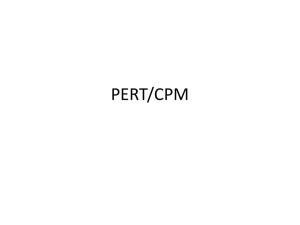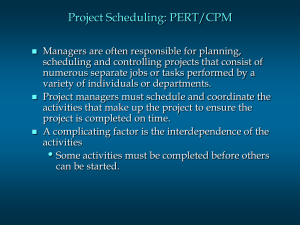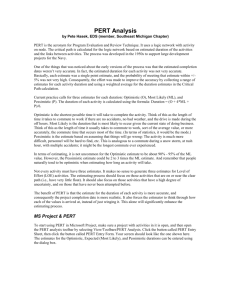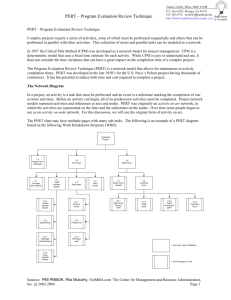Introduction - FreeQuality
advertisement
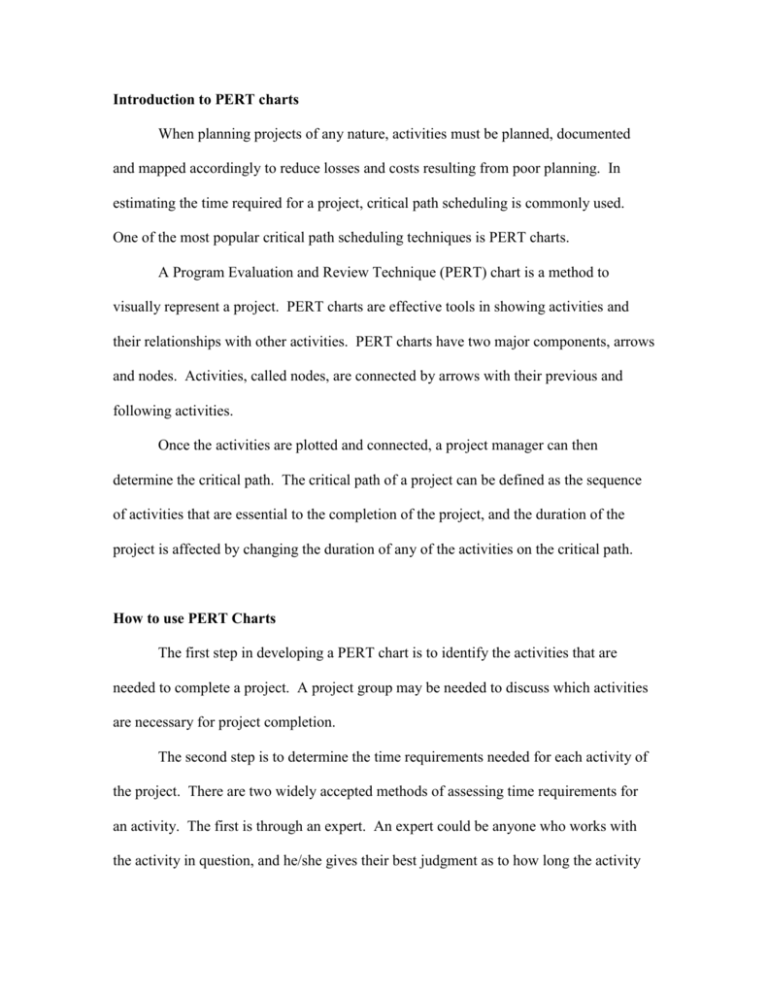
Introduction to PERT charts When planning projects of any nature, activities must be planned, documented and mapped accordingly to reduce losses and costs resulting from poor planning. In estimating the time required for a project, critical path scheduling is commonly used. One of the most popular critical path scheduling techniques is PERT charts. A Program Evaluation and Review Technique (PERT) chart is a method to visually represent a project. PERT charts are effective tools in showing activities and their relationships with other activities. PERT charts have two major components, arrows and nodes. Activities, called nodes, are connected by arrows with their previous and following activities. Once the activities are plotted and connected, a project manager can then determine the critical path. The critical path of a project can be defined as the sequence of activities that are essential to the completion of the project, and the duration of the project is affected by changing the duration of any of the activities on the critical path. How to use PERT Charts The first step in developing a PERT chart is to identify the activities that are needed to complete a project. A project group may be needed to discuss which activities are necessary for project completion. The second step is to determine the time requirements needed for each activity of the project. There are two widely accepted methods of assessing time requirements for an activity. The first is through an expert. An expert could be anyone who works with the activity in question, and he/she gives their best judgment as to how long the activity will take based on their best judgment. The other method is based on calculations. Once again, people in the field assess their opinions of how long the activity will last. Instead of taking only one opinion, the calculation comes from adding the optimistic activity completion time, plus four times the realistic activity completion time, plus the pessimistic activity completion time, all divided by six to arrive at the estimated activity completion time. ET = ( O + 4R + P ) /6 The next step is to physically construct the PERT chart. This can be done easily through software such as Microsoft Project. The sequence of activities are mapped out by determining precedence relationships and inter-relationships among activities. The final step is to determine the critical path for the project. The critical path is represented by the set of sequentially connected activities that take the least amount of time from start to finish. A delay in an activity on the critical path results in a delay of the overall project. Those activities not on the critical path can be delayed to a certain extent. These activities have slack time. Calculating slack time is a sub-step of critical path determination. To calculate slack time, first determine the earliest and latest expected completion times for each activity. To find the earliest completion time, take the expected time for each preceding activity, starting from left to right, and sum those times. The latest completion time is the latest time an activity can be completed without delaying the project. The latest completion time for each activity can be found by taking the finish time at the last activity, and working from right to left, and subtracting the estimated time from each activity. Activities on the critical path always have a slack time of zero. Activities that are not on the critical path have a slack time equal to the late finish time minus the early finish time. Slack time is the amount of time that activity can be late without affecting the completion time of the entire project. PERT CHART EXAMPLE PERT charts and the critical path method can be used in virtually all types of businesses. This simple example illustrates how PERT charts and critical path scheduling can assist a manufacturing firm. Joe’s Widget Company is in the business of producing widgets. Each widget consists of two parts, the upper and lower section of the widget. Both sections are then produced separately. The upper section is then painted to various colors while the lower section is stamped with Joe’s seal of approval for widget quality. Finally, both sections are taken to final assembly where they are then packaged and shipped to customers. The accompanying PERT chart shows all of the following steps: 1. Upper sub-assembly production 2. Lower sub-assembly production 3. Stamping of lower section 4. Painting of upper section 5. Final assembly Each of the preceding steps are labeled in the accompanying chart accordingly, with the estimated amount of time (in days) required to produce a batch at each step. Those steps with a shaded border are on the critical path. Need More Information concerning PERT charts? The following sources were used for this report and may be consulted for additional information concerning PERT charts, critical path scheduling and other activity network diagrams. 1. Hoffer, Jeffrey A. Modern Systems Analysis & Design. Reading, Massachusetts; Addison, Wesley, Longman Inc. 1999. 2. Anupindi, Ravi, Sunil Chopra, Sudhakar D. Deshmukh, Jan Van Mieghem, and Eitan Zemel. Managing Business Process Flows. Upper Saddle, NJ; PrenticeHall, 1999 3. Foster, Thomas. Managing Quality: An Integrative Approach. Upper Saddle River, NJ; Prentice-Hall, 2001. 4. Mizuno, Shigeru. Management for Quality Improvement: The Seven New QC Tools. Cambridge, MA; Productivity Press, 1979.

